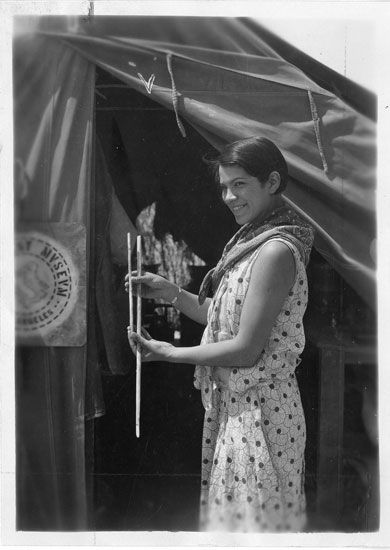Do You Know This Face? The Smithsonian Needs Help Identifying These Women Scientists
For Women’s History Month, the Smithsonian Institution Archives crowdsources the identification of unknown figures in decades-old portraits
/https://tf-cmsv2-smithsonianmag-media.s3.amazonaws.com/filer/20120321120007Elizabeth-Sabin-Goodwin-web.jpg)
Each March, the Smithsonian Institution Archives celebrates Women’s History Month by posting historical photographs of female scientists, science journalists and engineers to a Flickr Commons album. Taken from the 191os to 1960s, the portraits capture many women who were pioneers in their fields. But for a number of the photographs, however, there is little in terms of caption information identifying the women.
The women are pictured at their desks with microscopes, botanical illustrations or jarred specimens; standing at chalkboards displaying graphs and equations; and in labs tending to test tubes, beakers and petri dishes. A few are scraping away at archaeological sites.
“There are a lot of firsts,” says supervisory archivist Tammy Peters of the photos that are identified. “First woman to get a PhD in geology, or first woman to get this particular degree.”
The images come from a cache of records from a news organization called Science Service. Founded in 1921, Science Service popularized and disseminated scientific information. (It is now called the Society for Science & the Public.) ”It was kind of at the forefront of putting information about these women out there,” says Peters.
But with so many of the photos lacking identification, the Smithsonian Institution Archives decided it would reach out to the public for help in identifying and researching the scientists. Each March, a handful of largely unidentified portraits are posted to the Archives’ Flickr site.
“I was a little skeptical at first about what we could achieve through crowd-sourcing,” says Peters, “but we had really great success.” According to the archivist, the first real “OMG moment” was sparked by a photograph (above) posted in March 2009. In it, a young woman with a black bob, eyes deadlocked on the camera, sat at a desk, pen in hand. She was identified simply as “E.S. Goodwin.”
Thanks to the detective work of Flickr users, bits and pieces surfaced—first, her wedding announcement and then a high school yearbook photo. The woman was positively identified as Elizabeth Sabin Goodwin, an artist based in Washington, D.C. who had attended the Corcoran School of Art in the 1920s. Given that her portrait was in the Science Service files, the archives guessed that Goodwin was a scientific illustrator.
Then, came a surprise. Linda Goodwin Eisenstadt posted a comment: “This is my grandmother.” Eisenstadt was able to fill in many of the gaps in Goodwin’s life story. She lived from 1902 to 1980, and was, in fact, an illustrator for Science Service. In the 1920s, she drew cartoonographs, which comically illustrated political, social and economic statistics.

Marcel Chotkowski LaFollette, a research associate at the archives, compared drawings Eisenstadt provided to others in the Smithsonian collections and ultimately found 38 unsigned cartoonographs that she could comfortably attribute to Goodwin.
“This is still is one of my favourite ‘stories’ on Flickr,” wrote Flickr user Brenda Anderson.
Of the 15 photographs of scientists the archives posted this month, Peters has strong leads on eight. She was particularly curious about Bertha Pallan, an “expedition secretary” shown holding atlatl darts (right).
“Certain images are going to attract your attention. This was one of them,” says Peters. “It is a stunning picture.” So far, Flickr users have reported that Pallan grew up in Southern California in the early 1900s. She married three times; her third husband was Oscar Cody, or “Iron Eyes Cody,” an actor who played Indian roles in numerous 20th-Century American films. Most significantly, Pallan has been referred to as the first female Native American archaeologist. She was secretary for an expedition of the Gypsum Cave in Nevada, when this photograph was taken.
Perhaps you know more.
Browse through this year’s additions.
/https://tf-cmsv2-smithsonianmag-media.s3.amazonaws.com/accounts/headshot/megan.png)
/https://tf-cmsv2-smithsonianmag-media.s3.amazonaws.com/accounts/headshot/megan.png)